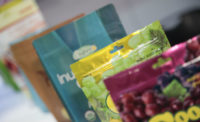Confectionery packaging equipment promotes adaptability, sustainability
Packaging solutions to be on display at interpack 2020, set for May 7-13 in Düsseldorf, Germany.

The confectionery and baked goods segment is an excellent example of the important impact packaging can have on consumer decisions at the point of sale (POS).
Almost no other industry benefits as strongly from seasonal trade, which depends considerably on packaging. And there are many occasions that call for colorful special editions: Mother’s Day, Valentine’s Day, Easter, Thanksgiving, Christmas and Halloween.
From year to year, trademark owners and packaging manufacturers outdo one another with new ideas for products, flavors and designs, all in accordance with customer demands. Because variety, after all, is what consumers desire above all else. Launching new and innovative products is one of the key success factors in the industry.
German chocolate manufacturer Ritter Sport has recognized this.
“Chocolate consumers are a lot like wine drinkers,” said Asmus Wolff, Ritter Sport managing director and supply chain manager. “Their tastes mature over the course of their lives. Accordingly, we have to ensure that our product remains captivating and offer consumers a wide variety of flavors. After all, our colorful variety is our brand essence.”
With a steady flow of new flavor combinations, Ritter Sport brings its colorful variety to chocolate selections in stores.
Food pairing is a new trend in the confectionery industry, translating to the combination of different ingredients. For example, combining chocolate with matcha and cranberry creates a multisensory taste experience when consumed.
Variations in textures and inclusions in confectionery and baked goods, as well as various packaging types and sizes, have led to a larger product variety in our supermarkets, as well as significantly more complex production processes. As a result, manufacturers of confectionery and baked goods and packaging experts have to be able to anticipate consumer demands and include these in production planning and delivery.
Responsive and adaptable
Being adaptable requires state-of-the-art technologies and equipment that meet the demands of smart manufacturing. At the upcoming interpack, which takes place in Düsseldorf from May 7-13, 2020, more than 1,000 exhibitors will showcase the new innovations that the industry has developed for this exact purpose.
In Hall 1, located directly next to the new southern entrance of Messe Düsseldorf, as well as in Halls 3 and 4, visitors can discover solutions and offers from the portfolio of the confectionery and baked goods sector and find out more about the latest industry trends.
As product variety increases, life-cycles of products shorten and batch sizes decrease. As a result, machines and plants have to be responsive and flexible. Short changeover times are in high demand, as are easy conversions of products, quantities and formats as well as modular concepts with the aid of which production and packaging lines can be combined and expanded as necessary.
Improving plant efficiency
Theegarten-Pactec, specialist for packaging machines, will present an entirely new development at interpack 2020.
“This new packaging machine combines 10 different types of packaging in one product and will set a new benchmark in the field of primary packaging,” says Steffen Hamelmann, marketing and PR manager at Theegarten-Pactec. “It is easy to change the specific modules for each packaging type, allowing the machine to quickly switch between different folding types. The newly developed machine also considerably increases maximum output from around 1,200 packed products per minute to 1,800 products per minute – always depending on the size of the product and the type of packaging.”
At interpack 2020, the world leader in the primary packaging segment for small-sized confectionery products will break new ground and present a secondary packaging solution. In the past, the high performance of these machines often led to problems at the interface to downstream packaging. The new plant has been designed specifically to connect directly to primary packaging systems by Theegarten-Pactec and is thus expected to lead to an increase in efficiency in the entire system of primary and secondary packaging.
Ralf Schäffer, head of distribution and member of the management board at Sollich KG, a manufacturer of specialized machines for the confectionery industry, is well aware of the challenges that arise from the consumer demand for more variety in production.
“The large variety of confectionery products means that it is virtually impossible for machines to ensure serial production,” Schäffer said. “With increasing automation and fast-paced changes, the challenge lies in remaining flexible. Family-run business Sollich takes customer demands as well as specific product requirements into account; these can even result in completely new designs. At the same time, the company has to bear short lead times in mind.”
The market for confectionery machines
The confectionery machine segment is characterized by high specialization and considerable process-related know-how. Strong fluctuations in international business are quite common in this sector, as it strongly depends on large-scale projects.
In 2018, the total volume of confectionery machines in international trade amounted to €972 million, according to VDMA statements. German plant manufacturers hold a leading position in the export business with a market share of 35 percent. This is followed by the Netherlands in second place, with a market share of 16 percent, and Italy in third place, with 14 percent.
Since as early as 2016, German manufacturers of confectionery machines have noticed a significant increase in deliveries to Africa and the Middle East. In these regions, globalization has led to an increase in the significance of protective packaging for higher-quality confectionery. This in turn needs to be tailored to meet the specific requirements that arise due to the usually quite challenging climatic conditions.
Besides visuals, these regions focus on hermetically sealed packaging that provides ideal product protection. Companies such as Theegarten-Pactec are working to ensure that in future, other attractive types of packaging besides tubular bags can provide sufficient protection for products in tropical climates.
Protection and hygiene
One topic that has had a lasting effect on the confectionery and baked goods sectors is safe and hygienic production conditions. Hygienic design is a key term that refers to the development of machines and equipment while taking the high demands on flawless production into account and complying with international standards and directives.
In this field, manufacturers avoid corners and cavities in their designs, as product residue, microorganisms and dirt can accumulate in these areas. This reduces cleaning costs and efforts, shortens downtimes and minimizes material waste. At the same time, the plant’s productivity increases.
These procedures, known as CIP (Cleaning in Place), have gained popularity in the last years. Special CIP sensors alert users when a machine needs cleaning. This avoids unnecessary, extensive cleaning processes and thus saves water, cleaning agents and energy, and with it, costs.
Especially when it comes to baked goods, strict hygiene conditions apply. This is because baked goods – and bread in particular – provide an ideal breeding ground for mold. Mold means re-contamination, as baked goods are always sterile when they come out of the baking ovens.
Special procedures and the right packaging can extend the shelf-lives of baked goods, meaning that industrially-packaged bread can keep for up to three weeks, depending on type. When it comes to small baked goods such as pre-baked rolls, industrial bakeries use the exchange of atmosphere in tubular packaging to extend shelf-lives. In this process, the oxygen content in the packaging is replaced by oxygen-free gases.
Pasteurization is another procedure that is often used. This involves maintaining a constant baking temperature of 75 degrees Celsius in the oven over an extended period of time. The procedure usually uses standard polyethylene bags with clip closures. These prevent too strong a pressure, which can result in bags inflating during the pasteurization process. At the same time, they are easy to open and close.
In future, food safety will gain further importance due to the continuing increase in globalization and the considerably more complex value chains and changing consumer habits. Climate change will also impact food safety. This applies particularly to locations in which changes in temperature related to the production, storage and distribution of food can change food safety risks. These factors, as well as the rising growth in population, mean new challenges for global food safety. As a result, food manufacturers and processors bear an even greater responsibility to produce safe and sustainable foods.
Thanks to digitalization and automation, bakery machines are also becoming more efficient and flexible in adapting to the rising consumption of baked goods and snacks on-the-go. As a result of changed shopping and eating habits and the increase in single-portion packaging, the global production of bakery machines has also risen.
According to VDMA statements, bakery machines (including non-electric baking ovens) achieved a turnover in international trade of over €2.7 billion in 2018. With a share of 31 percent, Italy is the largest manufacturer and exporter of bakery machines, including pasta machines. German machine manufacturers hold second place with a market share of 11 percent and the Netherlands come in third with a share of 7 percent.
Sustainable solutions
Sustainable production and packaging of confectionery and baked goods is one of the main issues industry participants are currently focusing on. In light of increasing global warming and the fact that global population is expected to grow to almost 10 billion people by 2050, solutions are in urgent demand – and have already arrived, as interpack 2020 will show.
The product range of global group Bühler, for example, includes Mill E3, an industrial milling solution. Thanks to the TUBO tubular conveyor, the integrated grinding system and the modular feeder systems, the Mill E3 takes up 30 percent less space and consumes 10 percent less energy, while at the same time increasing revenue. New baking ovens, like the Franz Haas SWAKT-Eco for flat and hollow wafers, are further able to reduce gas consumption by up to 30 percent and emissions by up to 90 percent.
During its Networking Days 2019, Bühler was one of several companies that proved the industry is prepared to assume responsibility and be part of the solution for a sustainable world in which food waste and loss is reduced to a minimum.
The company decided to increase their sustainability targets and to expand them to include water. The next generation of Bühler process solutions will be 50 percent more economical, which means consuming 50 percent less energy, 50 percent less water and producing 50 percent less waste.
With these targets, Bühler has assumed an exemplary role within the confectionery and baked goods industry. In order to achieve global climate goals, we need sustainable solutions like these. And this requires that we use digital technologies more intensively, and successfully establish partnerships with customers, suppliers and start-ups.
Looking for a reprint of this article?
From high-res PDFs to custom plaques, order your copy today!





